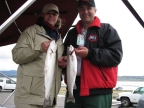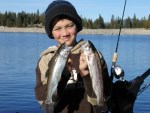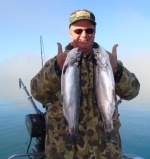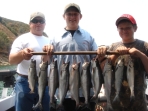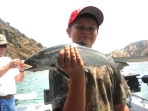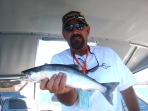The wind was blowing, the snow was falling and icy cold pierced through our parkas. From the south came three foot rollers topped with white caps. The boat pitched from side to side as we slow-trolled our offerings, anticipating the inevitable strike. As the line broke free of the downrigger's grasp, six pound monofilament ripped from the reel at a stunning rate. A sparkling spray of water exploded one hundred feet behind the boat as a five to six pound brilliantly colored rainbow trout broke the surface and burst glistening through the air. One prolonged run and five minutes later...the fish slid grudgingly to the net.
It is the lure of the Eagle Lake Rainbow Trout that brings outdoorsmen to this northeastern region of California. Known for it's exceptionally fast growth rate, trophy proportions, acrobatic drag-testing battles and excellent table fare, the Eagle Lake Trout is a highly sought after game fish.
From Eagle Lake's Memorial Day weekend opener until the seasonal closure at year's end, anglers will discover exceptional opportunities for this rare species of rainbow trout. Anglers can expect to find trout ranging in size from recent planters of 14-16 inches, to the large holdover population of fish in the three to six pound range. There are even larger trout prowling the depths of the lake and each year 'bows from five to eight pounds are caught by lucky anglers fortunate enough to be in the right place at the right time. The current lake record is an 11 1/4 pound rainbow taken in 1988. Native only to this prehistoric lake, this strain of rainbow trout has adapted to the highly alkaline waters.
During Spring and early Summer, anglers find the bow's feeding actively in the shallow, early season feeding ground, of the lake's north end where waters average only 15 feet in depth. As summer temperatures warm the shallows fish move to the deeper, cooler, spring-fed waters at the southern end of the lake. Downriggers or leadcore line are almost a necessity for trollers to get offerings to the required depths this time of year. During fall and early winter periods some of the largest fish of the year are intercepted by anglers as trout begin to drop their defenses. Cooler temperatures alert the bows that winter is coming and they begin to feed heavily to store the needed reserves of fat to sustain them through the cold months ahead. They scatter to all areas of the lake concentrating off points and rocky areas where they can gorge themselves on the lake's population of natural food sources. Ideal water temperatures at this time of year give these fish a distinct advantage of extraordinary endurance which often testing the anglers skill, dedication and tackle.
Eagle Lake trout fight like no other trout. They are bright, colorful, alert, acrobatic and possess steelhead-like fighting qualities. Whatever technique an angler prefers to subdue one of these trophy fish, proper presentation and tackle are vital. Rods of six to seven feet in length designed for fish from 2-8 pounds are just right for the task. Whether your choice is spinning or casting reels, it is a good idea to use light line in the 4-8 pound test range. The water is very clear and fish become leader shy. For the first time angler, it would be prudent to hire a guide. These experienced individuals who can teach a beginner more in a couple of hours what it might take years to learn on your own. The lake takes awhile to learn because of it's size and of course, wind, weather and moon cycles play important roles.
Eagle Lake was created by the melting of glaciers during the last ice age and it is the second largest natural lake in California. It covers 22,000 acres with over 100 miles of shoreline. Located at an elevation of 5,100 feet, it is surrounded by dense towering evergreen forests of pine and cedars at the south end and rugged, high elevation desert scrub on the northern most portion. |
Five National Forest campgrounds are nestled in the forest at the south end of the lake. Campsites are a stone's throw from the shore and full facilities including RV parks, grocery stores, tackle shops, boat and cabin rentals and restaurants are nearby at Spaulding and Stones Landing.
Anglers utilizing the proven techniques of still-fishing, fly fishing or trolling will find their greatest success in many of the lake's usual "hot spots". The shoreline in many areas is dotted with tulles and rocky areas that provide shelter to much of the natural food sources. Tui chub, red-side suckers, leeches, freshwater shrimp and aquatic and insect life find these areas ideal habitat and trout feed heavily both early and late in the day.
At Eagle Lake's north end, rainbows are routinely found near Troxel, Rocky and Bucks Points, but the heaviest fished areas are the Airport Tules, Lassen Youth Camp and Pelican Point. The Springs, Eagles Nest, and the breakwater at Eagle Lake Marina all produce good numbers of sizeable fish. Whether anchored or fishing from shore, the preferred tactic is casting a nightcrawler/bobber combination or simply letting a bare nightcrawler slowly drift and sink. Wildcat Point is another favorite for still-fishermen. This rocky outcropping located along the southwestern shoreline holds an abundance of insect and aquatic life for the rainbows to feed upon. Shrimp Island is a rocky underwater peninsula that traditionally holds good numbers of big holdover fish. Trolling is the preferred method here as the area is dotted with natural springs that attract trout and baitfish to these cool, highly oxygenated waters. Rainbows can be caught in the early morning, tight to the shoreline in as little as two to three feet of water but as the sun rises they will move to deeper safer waters.
Small flashers, a threaded nightcrawler or bright colored lures are the preferred method for trollers. Small minnow imitating lures like Needlefish, Pro Secrets, and Triple Teasers in pearl white, flame red, bright pink, or silver are good bets for the big bows. Large trolling flies in red and black, cinnamon, white or olive are remarkably good producers. They imitate the lake's natural baits and fool some of the largest fish caught each year. Fast trolling (2-3 mph) Rapalas or Speedy Shiners is another effective technique. Fly fishermen and float tubers should work the tules and shallows on the western shore. Wooly buggers in brown, black or olive produce well.
The above average rainfall and snow pack of the past two seasons have made the Eagle Lake basin lush and green once again. No longer are there exposed shorelines, extended beaches and shallow boat launch facilities. The lake has returned to it's scenic best and any outward signs of California's recent drought have completely disappeared.
Venturing to Eagle Lake any time of year requires advanced preparation and is not to be taken lightly. Weather conditions are very unpredictable and can turn a fun fishing trip into a horror story. It is vital to dress for cold and to have waterproofed raingear. Winds at Eagle Lake demand respect and white caps can appear without much warning. However, the discomfort created by winds and cold does have a benefit. As the wind and waves churn the surface waters, baitfish and minnows become increasingly disoriented and the food chain begins. Veteran anglers at Eagle Lake know from years of experience...the rougher the water...the better the fishing. The fish will continue to feed heavily before winter's extreme cold slows the action. Where else can anglers spend quality time, catching and releasing two to six pound rainbow trout with regularity? • |


